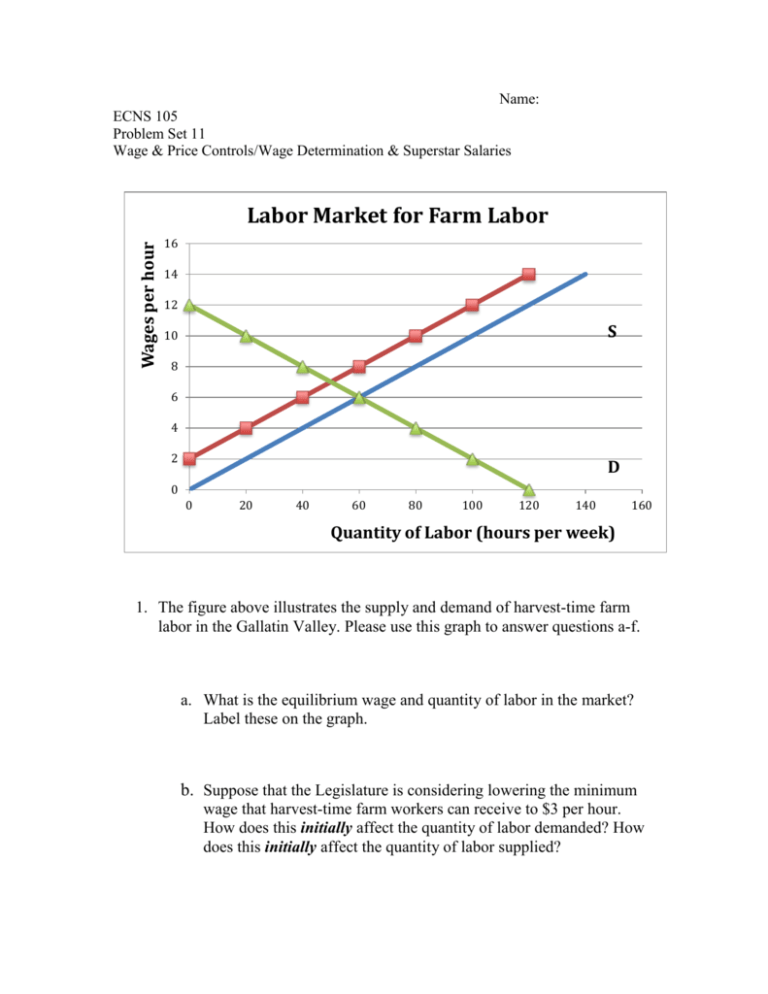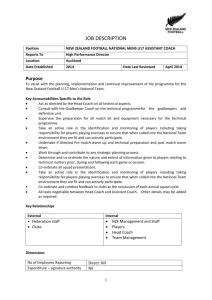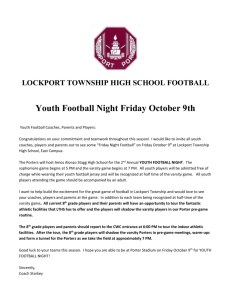Problem Set 11 - Montana State University
advertisement

Name: ECNS 105 Problem Set 11 Wage & Price Controls/Wage Determination & Superstar Salaries Wages per hour Labor Market for Farm Labor 16 14 12 S 10 8 6 4 2 D 0 0 20 40 60 80 100 120 140 160 Quantity of Labor (hours per week) 1. The figure above illustrates the supply and demand of harvest-time farm labor in the Gallatin Valley. Please use this graph to answer questions a-f. a. What is the equilibrium wage and quantity of labor in the market? Label these on the graph. b. Suppose that the Legislature is considering lowering the minimum wage that harvest-time farm workers can receive to $3 per hour. How does this initially affect the quantity of labor demanded? How does this initially affect the quantity of labor supplied? c. Suppose that the Legislature is considering lowering the minimum wage that harvest-time farm workers can receive to $3 per hour. Is there an initial shortage or an initial surplus of harvest-time farm labor in the market? What is the size of the shortage or surplus? (Please show your calculations.) d. Suppose that the Legislature is considering lowering the minimum wage that harvest-time farm workers can receive to $3 per hour. What is the wage that will prevail after market forces kick in? What is the quantity of labor that will prevail after market forces kick in? Explain. e. Instead, suppose that the Legislature is considering raising the minimum wage that harvest-time farm workers can receive to $6 per hour. How does this affect the quantity of labor demanded? How does this affect the quantity of labor supplied? Does this cause a shortage or surplus of labor in the market? Explain. f. Instead, suppose that the Legislature is considering raising the minimum wage that harvest-time farm workers can receive to $6 per hour. What is the quantity of labor that will be employed in the market? What is the wage that will prevail in the market? Explain. 2. Professional football players make significantly higher salaries than college professors do in the United States. Which of the following statements about this information is true? a. The higher salaries of football players are a reflection of the higher supply of football players relative to college professors. b. The higher salaries of football players are a reflection of the higher marginal value that Americans place on services of football players than on the services of college professors. c. The higher salaries of football players are a reflection of the higher total value that Americans place on services of football players than on the services of college professors. d. The higher salaries of football players are a reflection of their higher value of marginal product relative to that of college professors. e. Both b and d are true f. All of the above are true 3. Your BFF from high school tells you that it is not fair that professors at major universities make significantly less than most point guards on professional basketball teams. Applying the economic way of thinking, you would argue that the situation is fair because a. There is higher demand for professors b. Professors do not know how to shoot a basketball because they spent too much time studying c. A person is more likely to pay $100.00 to see an athlete than hear a professor lecture d. Athletes have more expensive tastes than professors and must make more to live comfortably 4. Using the concept of the value of the marginal product of labor (VMPL), explain in 2-3 sentences why WNBA players earn lower salaries than NBA players do. 5. A seatbelt manufacturing company hires factory workers to produce seatbelts according to the production function in the table below. Use this table to answer parts a-b. Factory Workers/hour 0 1 2 3 4 5 Total Product (seatbelts/hour) 0 40 70 90 105 111 a. This company prices its seatbelts at $12 each and factory workers’ wages are $40 per hour. Factory workers’ wages represent the company’s only cost of production. Based on this information, what is the total revenue when the company hires 4 factory workers per hour? (Please show your calculations.) b. A seatbelt manufacturing company hires factory workers to produce seatbelts according to the production function in the table below. Suppose this company lowers its seatbelt prices to $8 each and factory workers’ wages are $70 per hour. Factory workers’ wages represent the company’s only cost of production. Based on this information, what is the optimum number of factory workers for the company to hire? (Please show your calculations.) 6. A new grain elevator is opening in Bozeman. Each laborer will be paid $13.00/hour. Six applicants were interviewed and the owner estimated each individual’s value of marginal product based on the interview and application. a. What economic criteria could the manager use for making these decisions? b. In the table below, write whether or not each applicant would be hired. Applicant # 1 2 3 4 5 6 Value of Marginal Hire? Product ($ per hour) 10 13 18 12 11 8 c. If the owner needs 7 laborers to run his elevator, how many more applicants will he have to hire?





